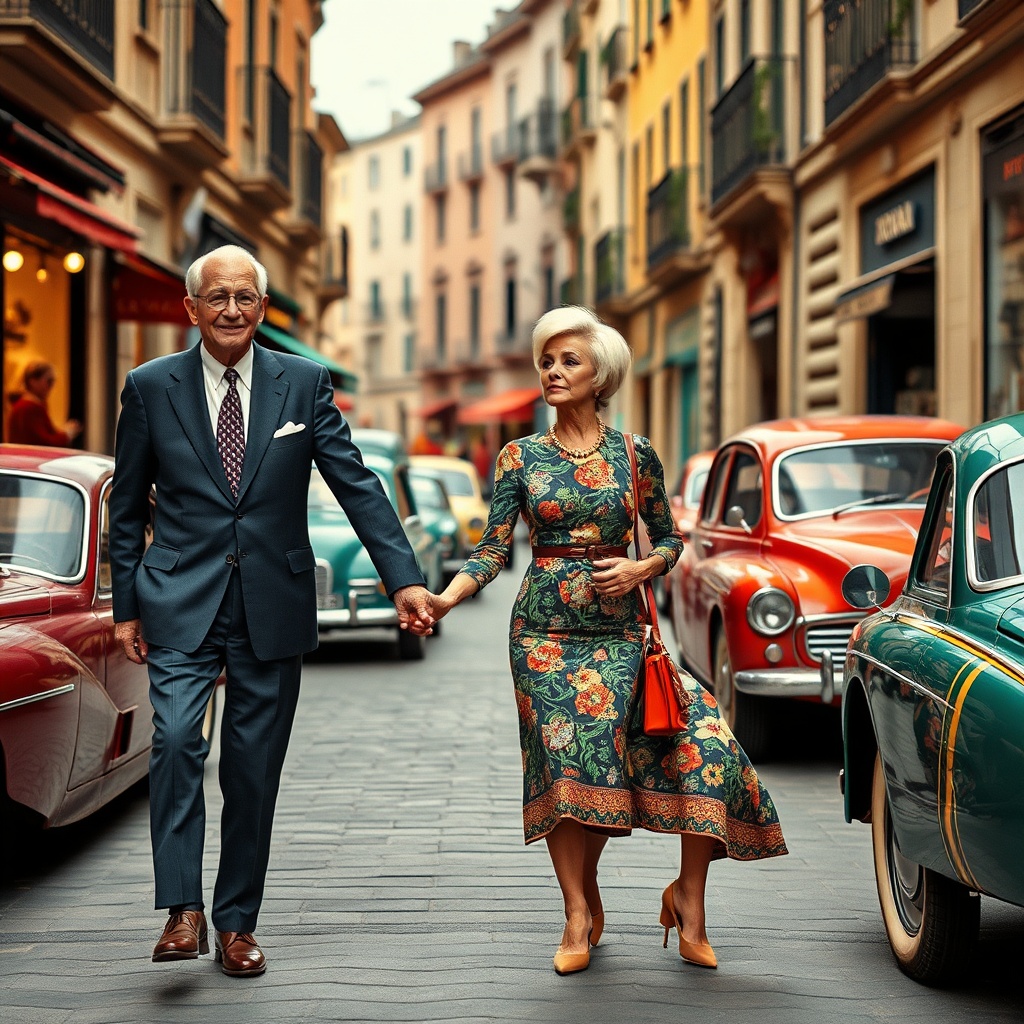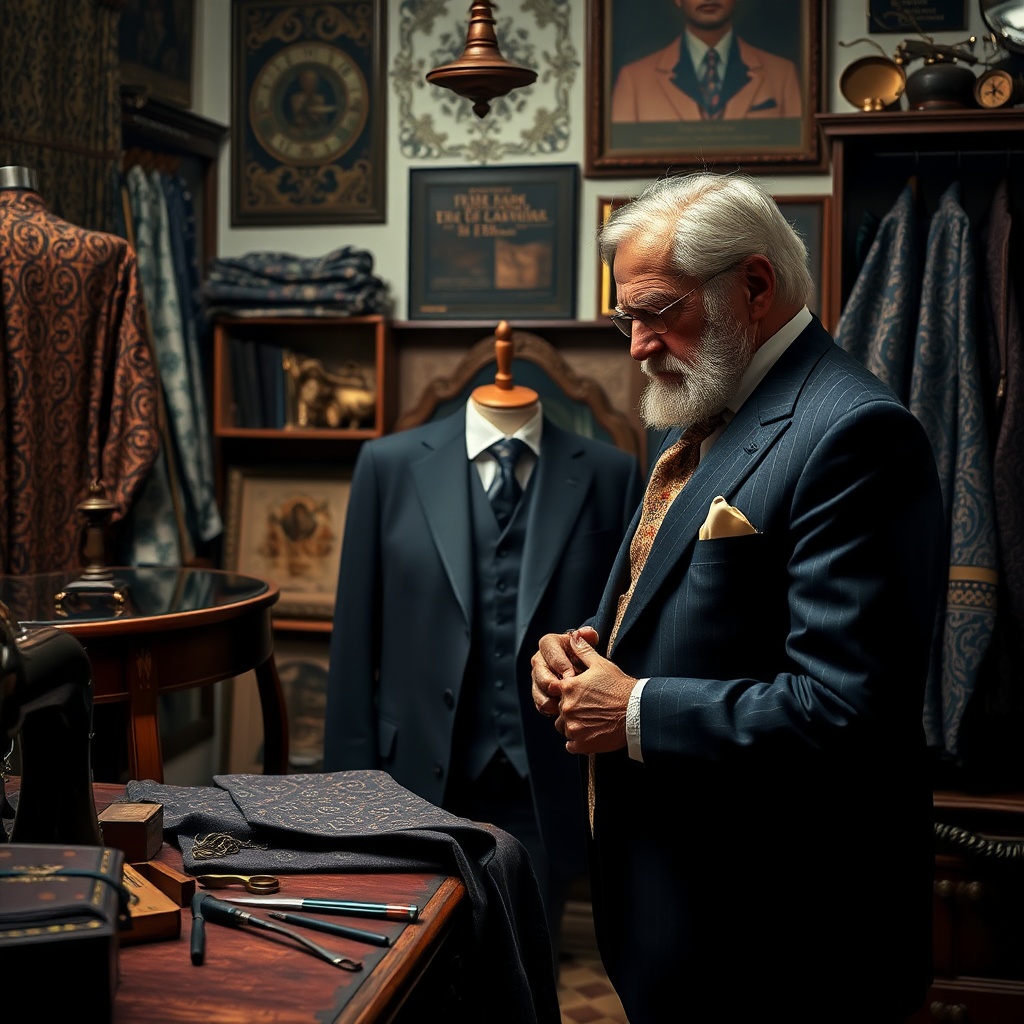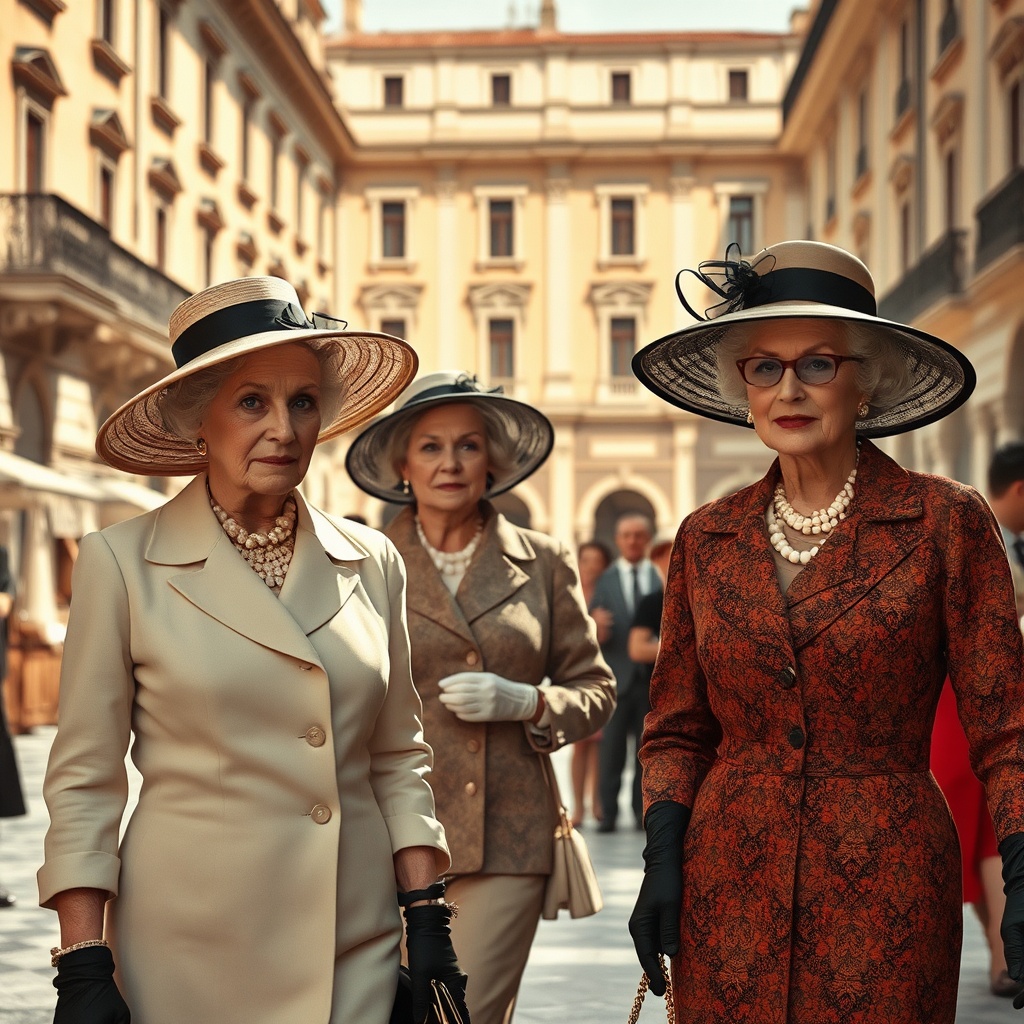Rediscovering the Glamour: Iconic Italian Designers of the 1960s

Introduction to Italian Fashion in the 1960s
The 1960s marked a pivotal era in the world of fashion, particularly in Italy, where a fusion of art, culture, and style gave birth to unforgettable designs. This was a decade where glamour was not just a trend but a way of life.
Iconic Designers Who Shaped the Decade
Let’s embark on a journey to rediscover the brilliance of these legendary designers who defined the essence of Italian fashion in the 1960s:
- Gianni Versace: Known for his bold prints and vibrant colors, Versace brought a sense of exuberance to the fashion scene.
- Valentino Garavani: His romantic silhouettes and exquisite craftsmanship made Valentino a household name, especially with his famous red dresses.
- Giorgio Armani: Renowned for his innovative designs that blended comfort with elegance, Armani revolutionized menswear.
- Prada: Miuccia Prada introduced a new wave of minimalist fashion that emphasized understated luxury.
- Fendi: Famous for their luxurious fur designs and the iconic baguette bag, Fendi was a staple of high-end fashion.
The Influence of Art and Culture
The 1960s was not just about fashion; it was a time when artistic movements like Pop Art and the Italian Renaissance influenced designers. What was your favorite art movement from that time? The interplay between fashion and art was vividly seen in the works of:
- Salvatore Ferragamo: His innovative shoe designs were a perfect blend of functionality and elegance.
- Missoni: Known for their colorful knits and zigzag patterns, Missoni brought a playful touch to high fashion.
Fashion Icons of the 1960s
Fashion was also defined by the stars who wore these exquisite pieces. Can you recall any fashion icons from the 1960s? Some notable figures included:
- Audrey Hepburn: Often seen in Givenchy designs, Hepburn embodied elegance and sophistication.
- Brigitte Bardot: With her effortless style and playful attitude, Bardot became a muse for many designers.
Conclusion: The Legacy of 1960s Italian Fashion
As we reflect on the golden age of Italian fashion, it’s evident that the creativity and innovation of this era continue to inspire modern designers. What aspects of 1960s fashion resonate with you today? Whether it’s the elegance of a Valentino gown or the boldness of a Versace print, the glamour of the 1960s remains timeless.
Fashioning Identity: How Italian Style Shaped a Generation

The 1960s were a transformative decade in fashion, particularly for Italy, where style was not just about clothing but also about identity. This era showcased a unique blend of art, culture, and innovation, leading to a renaissance in Italian fashion that still resonates today. Let’s explore how Italian style shaped a generation and created a lasting impact on global fashion.
The Influence of Italian Designers
Italian designers emerged as leaders in the fashion world during this period. Their contributions were not just about garments but also about expressing individuality and cultural identity. Here are some key figures:
- Gianni Versace – Known for his bold prints and vibrant colors, he revolutionized glamour.
- Valentino Garavani – Famous for his romantic gowns and the iconic ‘Valentino Red’.
- Giorgio Armani – Pioneer of relaxed silhouettes that emphasized comfort without sacrificing elegance.
Fashion as a Cultural Movement
Fashion in the 1960s was deeply intertwined with cultural movements, including:
- Counterculture: The youth embraced more casual, expressive styles, reflecting a rejection of traditional norms.
- Film: Italian cinema, featuring stars like Sophia Loren and Marcello Mastroianni, showcased luxurious Italian fashion on the silver screen.
- Art: The influence of Italian artists and their avant-garde movements helped shape the aesthetic of fashion.
The Role of Iconic Fabrics and Techniques
Italian fashion was characterized by the use of high-quality materials and innovative techniques. Some of the most notable included:
| Fabric | Description |
|---|---|
| Silk | Luxurious and soft, used in evening wear and accessories. |
| Cashmere | Soft and warm, ideal for sweaters and coats. |
| Linen | Light and breathable, perfect for summer collections. |
Impact on Global Fashion
The influence of Italian fashion extended far beyond its borders. Designers and trends from Italy inspired styles worldwide:
- Runway Influence: Italian designers set trends that were adopted by international fashion houses.
- Street Style: The casual chic style popularized in Italy became a global phenomenon.
- Luxury Brands: The emergence of luxury brands from Italy, such as Gucci and Prada, created a new standard for fashion excellence.
As we reflect on the golden age of Italian fashion in the 1960s, it is evident that this era was not just about clothing. It was about crafting an identity that celebrated individuality, creativity, and sophistication. The legacy of Italian style continues to inspire new generations, reminding us that fashion is a powerful form of self-expression.
The Art of Tailoring: Masterpieces from Italian Couture Houses

Discovering the Craftsmanship of Italian Tailoring
The 1960s was a decade that redefined fashion, and at the heart of this evolution was the unparalleled art of tailoring. Italian couture houses became synonymous with exquisite craftsmanship, elegance, and an eye for detail. Have you ever wondered what made these designs so special? Let’s take a closer look!
Iconic Couture Houses
Throughout the 1960s, several prestigious Italian fashion houses rose to prominence. Each of these houses brought a unique flair to the art of tailoring:
Gucci: Known for its luxurious materials and innovative styles, Gucci set trends that echoed throughout the fashion world.
Versace: With bold colors and daring designs, Versace captured the spirit of the era, pushing the boundaries of traditional tailoring.
Armani: Giorgio Armani revolutionized menswear with his relaxed yet refined silhouettes, emphasizing comfort without sacrificing elegance.
The Elements of Masterful Tailoring
What constitutes masterful tailoring? Here are some key elements that define the masterpieces from Italian couture houses:
Precision Cut: Every piece is meticulously cut to enhance the wearer’s shape, ensuring a perfect fit.
Luxurious Fabrics: The use of high-quality materials, such as silk and cashmere, plays a crucial role in the overall look and feel of the garments.
Handcrafted Details: From intricate stitching to unique embellishments, handmade details elevate each piece to a work of art.
Timeless Styles and Trends
The styles that emerged from this era continue to influence modern fashion. Think of the classic Italian suit or the elegant evening dresses that featured flowing lines and dramatic silhouettes. How do you feel about these timeless trends? They remind us that fashion is not just about clothing; it’s about self-expression.
Preserving the Legacy
As we explore the legacy of 1960s Italian fashion, it is essential to appreciate the artistry that went into each piece. Museums and exhibitions around the world showcase these masterpieces, allowing new generations to experience the beauty of Italian tailoring. Have you had the chance to visit any fashion exhibits?
Conclusion: The Enduring Influence of Italian Tailoring
The golden age of Italian fashion was more than a time of style; it was an era where tailoring transformed into an art form. The elegance of the 1960s continues to inspire today’s designers, reminding us that true fashion is always in style. What aspects of Italian fashion resonate with you the most?
A Journey Through Time: The Influential Trends of the 1960s
Introduction to the 1960s Fashion Revolution
The 1960s marked a dynamic shift in fashion, particularly in Italy, where creativity and innovation flourished. This era was characterized by a blend of tradition and modernity, giving birth to trends that still influence designers today.
Key Influences and Icons
Fashion icons such as Giorgio Armani and Valentino Garavani emerged during this time, setting the stage for what would become known as Italian chic. These designers drew inspiration from various sources including art, cinema, and the cultural movements of the day.
The Birth of Ready-to-Wear
Ready-to-wear fashion gained immense popularity, making high fashion accessible to the masses. This trend was not just about affordability; it signified a cultural shift where fashion became a form of self-expression.
The Shift to Youth Culture
As the youth culture began to rise, so did the need for fashion that reflected the vibrant spirit of the times. Mini skirts and mod styles became the epitome of youthful exuberance, symbolizing freedom and rebellion.
Colors and Patterns
The 1960s were vibrant, with bold colors and patterns dominating the scene. Geometric prints and psychedelic designs became staples, setting a tone of optimism and creativity that resonated with the societal changes occurring around the globe.
Iconic Fabrics and Textures
Silk, chiffon, and tweed were often used, allowing for both elegance and comfort. The luxurious feel of these fabrics added to the timeless appeal of 1960s Italian fashion.
Fashion in Cinema
Italian cinema played a significant role in shaping fashion trends. Films featuring stars like Sophia Loren and Claudia Cardinale showcased stunning outfits that inspired countless fashionistas and designers alike.
The Legacy of 1960s Fashion
The influence of 1960s fashion is still evident today. Concepts of sustainability and individuality that were born during this era continue to resonate, proving that true style is indeed timeless.
As we reflect on the influential trends of the 1960s, it is clear that this decade was not just about clothing; it was about a cultural revolution that celebrated creativity, individuality, and the beauty of expression. The essence of that time continues to inspire and shape the world of fashion today.
Starlit Runways: Legendary Fashion Shows That Captivated the World
Introduction to a Glamorous Era
Imagine a world where every runway was a stage, where models glided gracefully, and where each outfit told a story of luxury and artistry. The 1960s was a decade that witnessed the emergence of Italian fashion as a formidable force on the global stage. Designers like Gianni Versace, Giorgio Armani, and Valentino Garavani transformed the fashion landscape, captivating audiences with their innovative designs.
The Runway Revolution
The fashion shows of the 1960s were not just events; they were cultural phenomena. Each presentation was a carefully curated spectacle, a blend of theater and artistry. As you recall those days, think about the anticipation that filled the air as the lights dimmed and the music began to play. It was a moment when time stood still.
Iconic Shows That Redefined Fashion
Among the most memorable fashion shows, the 1966 Valentino Collection stands out. Held in the heart of Rome, it showcased designs that epitomized elegance. The stunning red gown, known as the ‘Red Dress’, became a symbol of passion and sophistication. Can you picture the fabric flowing, shimmering under the lights, as it made its way down the runway?
Fendi’s Bold Statements
Another iconic event was the Fendi 1965 show in Milan, where the designers made bold statements with their fur creations. These were not just garments; they were declarations of style. The audience was left in awe, witnessing the perfect marriage of craftsmanship and creativity. Do you remember the chatter among friends as they discussed the latest trends emerging from these shows?
The Cultural Impact
These legendary fashion shows did more than just showcase clothing; they shaped society’s perception of beauty and sophistication. The glamour of the runways influenced not only fashion but also art and cinema. Stars like Audrey Hepburn and Sophia Loren became muses for designers, embodying the elegance that defined the era. How did these icons inspire your own fashion choices in those days?
Engaging with the Past
As we reminisce about the golden age of Italian fashion, consider how these legendary shows have left an indelible mark on the industry. Each collection, each model, and each designer contributed to a rich tapestry of creativity that continues to inspire today. What memories do you hold dear from that enchanting time?
Conclusion: A Legacy of Elegance
The starlit runways of the 1960s remain a testament to the timeless elegance of Italian fashion. They remind us that style is not merely about clothing; it’s an expression of art, culture, and identity. Let us continue to celebrate this legacy, cherishing the beauty that once captivated the world.
Fabric of Dreams: The Luxurious Textiles Defining Italian Fashion
Introduction to Italian Textiles
In the vibrant tapestry of the 1960s, Italian fashion stood as a beacon of style and sophistication. This era, often referred to as the Golden Age of Italian fashion, was characterized by a remarkable array of fabrics that not only defined the look of the time but also encapsulated the spirit of luxury. Can you recall a fabric that captivated your senses?
The Role of Fabrics in Fashion
Fabrics are the very backbone of fashion. They breathe life into designs and evoke emotions. In the 1960s, Italian designers embraced an eclectic mix of textiles, each telling a unique story. Think about your favorite outfit from this era. What fabric did it feature?
Luxurious Silks
Silk, the queen of fabrics, was a staple in many Italian wardrobes. Silk satin and silk chiffon became synonymous with elegance and were often used in evening wear. Imagine the way silk feels against your skin—smooth, soft, and effortlessly glamorous. Did you ever wear a silk dress that made you feel like royalty?
Vibrant Cottons
In contrast, cotton offered a practical yet chic alternative for daytime wear. Designers crafted stunning cotton prints that reflected the vibrant culture of the era. Picture those brightly colored dresses adorned with bold patterns. What colors or patterns do you remember?
Exquisite Wools
As the seasons changed, wool emerged as a favored textile for tailored suits and outerwear. The fine quality of Italian wool provided warmth without compromising on style. Have you ever experienced the comfort of a finely tailored wool coat?
Innovative Synthetics
The 1960s also saw the rise of synthetic fabrics, which allowed for new textures and designs. Polyester and nylon became popular choices for their versatility and ease of care. What do you think about the evolution of fabrics? Do you prefer the classics or the innovations?
Conclusion: The Legacy of 1960s Fabrics
The luxurious textiles of 1960s Italian fashion continue to inspire designers today. They remind us of a time when fashion was not just about clothes, but about the stories they told and the memories they created. What memories do you cherish from this golden era of fashion?
Cinematic Chic: How Film Influenced 1960s Italian Style
In the vibrant tapestry of 1960s Italy, cinema played a pivotal role in shaping fashion trends, creating a symbiotic relationship between the silver screen and the runways. As you reminisce about that era, let’s explore how the enchanting world of film influenced the iconic styles of the time.
Iconic Film Stars
During the 1960s, Italian cinema was graced by unforgettable stars such as Audrey Hepburn in “Breakfast at Tiffany’s” and Claudia Cardinale in “The Leopard”. Their enchanting performances often showcased the elegant fashions of the era, setting trends that resonated far beyond the theater. Remember the stunning black dresses and sophisticated accessories? These became staples in women’s wardrobes across Italy.
The Influence of Neorealism
The Italian Neorealism movement also left an indelible mark on fashion. Films like “Bicycle Thieves” portrayed a raw and authentic view of life, influencing everyday wear. The focus shifted to practicality and comfort, with an emphasis on tailored pieces that exuded understated elegance. Can you recall the simplicity yet sophistication of those outfits?
Designers and Their Cinematic Collaborations
Designers such as Giorgio Armani and Valentino began to draw inspiration from the cinematic world. Valentino’s partnership with the films of the time brought his designs to life on screen, elevating his creations to iconic status. The “Valentino Red” became synonymous with glamour and passion, often seen on leading ladies.
Fashion Shows and Film Premieres
Fashion shows were not just about the clothes; they became events in themselves, often paired with film premieres. Can you picture the buzz surrounding these events? Guests would don the latest creations, allowing designers to showcase their work in a cinematic context. The glamour of the red carpet became a fashion runway, blurring the lines between film and fashion.
Conclusion: A Lasting Legacy
The symbiotic relationship between film and fashion in 1960s Italy created a legacy that continues to influence designers and filmmakers today. As you reflect on this golden age, consider how these cinematic moments captured the essence of Italian elegance and style. Which film or outfit from that era still resonates with you today?
Timeless Icons: Celebrating the Fashion Legends of the Era
Introduction to the 1960s Fashion Renaissance
The 1960s marked a revolutionary period in the world of fashion, especially in Italy. It was a time when creativity flourished, and iconic designers emerged, shaping styles that are still celebrated today. Let’s delve into the legendary figures who left an indelible mark on this glamorous decade.
Key Fashion Icons
| Designer | Signature Style | Notable Contributions |
|---|---|---|
| Gianni Versace | Bold Patterns and Bright Colors | Introduced sensuality and vibrancy to women’s fashion. |
| Valentino Garavani | Romantic and Elegant Designs | Known for exquisite evening wear and the iconic ‘Valentino Red’. |
| Giorgio Armani | Tailored and Structured Silhouettes | Pioneered the relaxed yet sophisticated style for both men and women. |
| Missoni | Colorful Knits and Zigzag Patterns | Revolutionized knitwear with unique textures and patterns. |
| Pucci | Graphic Prints and Fluid Shapes | Known for vibrant prints that embodied the spirit of the 60s. |
Influence on Popular Culture
Fashion in the 1960s was not just about clothing; it was a reflection of the cultural shifts occurring around the globe. Icons like Audrey Hepburn and Brigitte Bardot epitomized the elegant styles of the era. Their influence extended beyond fashion, impacting film and music, and inspiring countless individuals to embrace a new sense of freedom and expression.
Legacy of Italian Fashion
The legacy of Italian fashion from the 1960s continues to resonate today. The craftsmanship, creativity, and innovation of that era laid the foundation for modern design. As we celebrate these timeless icons, we also honor the spirit of an age that valued elegance, individuality, and artistry.
Interactive Reflection
Think back to your favorite fashion moments from the 1960s. Perhaps you remember the joy of wearing a stunning dress by Valentino or the excitement of a night out in a chic ensemble inspired by Versace. How did these fashion legends influence your personal style? Share your stories and memories with those around you, and let’s celebrate the enduring impact of Italian fashion together!
Cultural Crossroads: The Fusion of Art and Fashion in Italy
The Intersection of Art and Fashion
Italy in the 1960s was not just a hub of fashion; it was a vibrant cultural crossroads where art and fashion intertwined seamlessly. This era witnessed a remarkable dialogue between renowned artists and visionary designers, creating a unique style that echoed the sentiments of the time.
Embracing Artistic Influence
As you explore this fascinating period, think about how the artistic movements of the day, such as Surrealism and Abstract Expressionism, influenced designers like Giorgio Armani and Valentino Garavani. Their works were not just about clothing but were expressions of art that reflected the social and political climates of the era.
Fashion as a Canvas
Imagine walking through a gallery where each piece of fashion is a canvas. Designers used fabrics and silhouettes to convey messages, much like artists used paint and brush. For instance, the bold colors and geometric patterns of the Mod fashion movement were akin to the works of artists like Lucio Fontana.
Interactive Experience
- Visualize: Picture a runway that doubles as an art gallery. How do the designs transform the space?
- Reflect: Consider how fashion can tell a story—what stories did the 1960s Italian fashion tell you?
- Engage: If you could wear a piece from this era, which designer would you choose and why?
Legacy of Collaboration
The collaborations between artists and designers shaped a legacy that continues today. Think of the impact of Milan Fashion Week, which began to take shape in this decade, showcasing not just clothing but the fusion of various artistic expressions.
As we reminisce about this golden age, let us appreciate how the fusion of art and fashion in Italy created timeless elegance that transcends generations. The dialogue between these two creative fields continues to inspire, reminding us that fashion is, indeed, a form of art.
A Legacy of Elegance: The Enduring Influence of 1960s Italian Fashion
The 1960s marked a pivotal decade for fashion, especially in Italy, where a unique blend of art, culture, and style emerged. This era not only defined what elegance meant but also established trends that continue to influence the fashion world today.
The Icons of Italian Fashion
During this time, renowned designers such as Gianni Versace, Valentino Garavani, and Giorgio Armani came to prominence. Their creations were characterized by exceptional craftsmanship and innovative designs that captured the imagination of the public. Do you remember any of these designers? Perhaps a dress or suit that left a lasting impression?
The Influence of Cinema
Italian cinema played a significant role in popularizing fashion. Movies featuring Audrey Hepburn and Sophia Loren showcased Italian designers, making their styles iconic. How many films can you recall that featured stunning fashion from this era? The glamour of the silver screen helped set trends that were eagerly adopted by the masses.
Fashion as Art
Italian fashion was not just about clothing; it was a form of art. Designers incorporated bold colors, intricate patterns, and luxurious fabrics, making fashion shows a spectacle. Can you think of a particular outfit that felt like a piece of art? The attention to detail and the passion for creativity were evident in every piece.
Enduring Trends and Styles
The hallmark styles of the 1960s continue to resonate today. Bell-bottoms, mini skirts, and tailored suits have made comebacks in modern fashion. Have you seen any contemporary clothing that reminds you of the elegance of the 1960s? These styles have been reinterpreted, yet their essence remains unchanged, highlighting the enduring legacy of that era.
The elegance of 1960s Italian fashion is not just a memory; it is a lasting influence that shapes how we perceive style today. Reflecting on this period can inspire a renewed appreciation for the artistry and sophistication that defined a generation. What are your personal memories associated with 1960s fashion? Let’s celebrate the timeless elegance that continues to inspire us.
